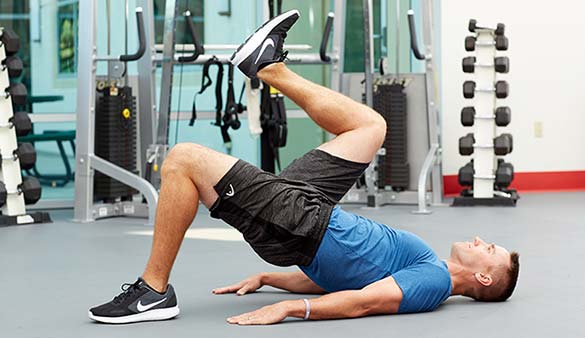
High-intensity interval training (HIIT) gets plenty of attention, but before HIIT was popular, there were circuits. In fact, circuit training has never really gone out of style because it’s such a simple way to keep workouts fresh. Although you could infuse HIIT into a circuit—research shows this protocol enhances fitness within a time-efficient framework—that’s only one programming option of many (Skidmore, 2012). Even a lower-intensity circuit comprised of just strength exercises can elicit a good cardiovascular response (Kravitz, 2005; Gotshalk, Berger and Kraemer, 2004).
In addition to being versatile, circuits are the perfect solution for leveraging fitness equipment when you don’t have a wide range of equipment from which to choose. You only need one or two pieces of equipment per station versus per client or participant. Even using just body weight across the board can provide an adequate training load within a circuit design (Klika and Jordan, 2013). Think of circuits as a good opportunity to get creative, says Mike Z. Robinson, 2015 IDEA Personal Trainer of the Year and owner of MZR Fitness in San Luis Obispo, Calif.
Regardless of equipment or design, Brett Klika says there’s one “golden rule” that fitness pros must observe: Know the circuit’s purpose or outcome. “Randomness does not move clients toward their goals and, actually, it significantly contributes to injury and [attrition],” says Klika, 2013 IDEA Personal Trainer of the Year, CEO-SPIDERfit Kids in San Diego, Calif., and author of 7 Minutes to Fit.
“When planning a circuit, the first things you should consider are clients’ needs and goals,” says Carol Murphy, 2010 IDEA Fitness Instructor of the Year, international fitness expert and motivational speaker based in Fairport, N.Y. “Plan regressions and progressions for each exercise,” she says.
You can start with exercise selection, but don’t stop there. Where in the circuit will each exercise go, and why? Map out the entire circuit in advance to ensure correct sequencing, advises Krista Popowych, 2014 IDEA Fitness Instructor of the Year, fitness consultant and educator in Vancouver, British Columbia. “Think about muscle focus, movement patterning, intensity and flow,” she says.
ACE asked the four experts quoted here to recommend different types of circuits that fitness pros can instantly apply to workouts for themselves, clients or classes. Most moves will work for anything from a single-client session to small-group training to a large class; modify as needed for your clients.
Cardio + Strength Circuit
Courtesy of Krista Popowych, fitness consultant and educator, Vancouver, British Columbia
Number of Stations: 6
|
|
Circuit Set-up: 60 seconds per station, 15 seconds transition. Recover for 90 seconds between circuits; two rounds total (switching lead legs on second round if applicable) Equipment: dumbbells, body weight
|
|
Popowych’s Tip: The trainer/instructor must be in full command of the group during a circuit. A lost instructor is a lost group. Think of your role as part coach, part “traffic controller.”
|
Station 1
Tire Runs—At a fast pace, run in and out of an imaginary tire on the ground, alternating between a wide stance and a narrow stance while running on the spot. Keep knees high.
Station 2
Squat to Stand—Holding heavy dumbbells, squat down and place dumbbells on the floor. Return to standing and then immediately squat down again, picking up the dumbbells. Return to standing and repeat the sequence.
Station 3
Skaters—Holding one dumbbell in both hands, power jump from side to side three times total (i.e., right to left, left to right, right to left). After doing three lateral jumps, immediately perform a single-leg hop/jump on the spot using the leg on which you finished the lateral jumps. Repeat on the other side.
Station 4
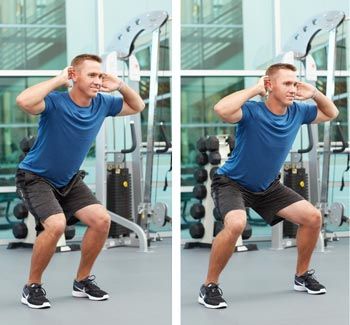
Modified Chair—Starting in a yoga-inspired “chair” position (i.e., isometric squat), place hands behind the head, keeping the core, lower traps and rhomboids active. Still in the squat position, “walk” the feet wide and then back to about hip-width distance apart.
Station 5
Long Jump + Shuffle Back—Jump forward as far as possible; shuffle/run backwards quickly. Repeat.
Station 6
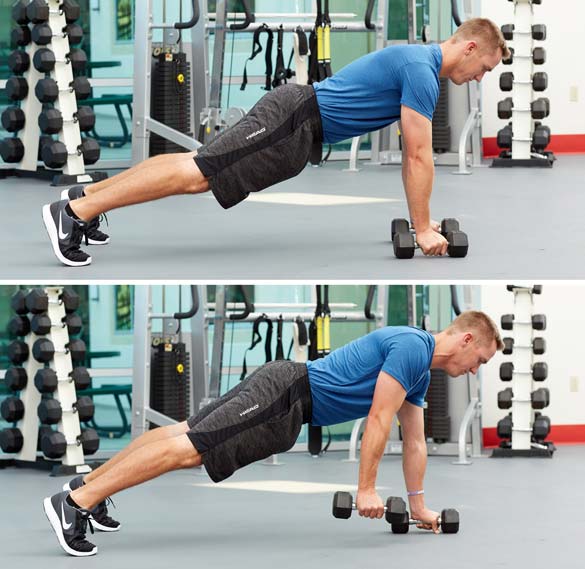
Plank Circle—Begin in a straight-arm plank, holding a dumbbell in the right hand (place the left hand on the floor or hold another dumbbell against the floor). Lift the hand slightly off the floor so the arm is reaching down toward the floor, with the hand aligned under the shoulder. Make a circle in the air with the dumbbell as if “drawing” the circle on the floor with the dumbbell. Do eight reps and then switch the dumbbell to the left arm; repeat. Continue switching arms and the direction of the circles.
HIIT Circuit
Courtesy of Brett Klika, CEO-SPIDERfit Kids, San Diego, Calif.
Number of Stations: 4
|
|
Circuit Set-up: 30 seconds per station, 10 to 15 seconds transition. Recover between each round of all four exercises for 60 seconds; four rounds total. Equipment: dumbbells, TRX or bar, two cones, medicine ball
|
|
Klika’s Tip: For high-intensity circuits, select exercises that have a clear criteria; for example, running/rowing/cycling for a certain distance at a certain speed, or doing X number of repetitions in a certain timeframe. These criteria can be adapted to each individual.
|
Station 1
Thrusters—Hold a dumbbell in each hand, resting them on the shoulders; perform a squat. Extend the arms overhead as you return to standing. Follow a cadence of two counts down, one count up.
Station 2
Horizontal Rows—Hang from a TRX or bar and perform pull-ups. The bar or hands in the TRX should reach mid-chest. Follow a cadence of two counts down, one count up.
Station 3
Line Shuffles—Set two cones or dumbbells on the floor roughly 5 yards apart. Shuffle laterally from the first to the second cone and back five times, attempting to complete the drill in less than 10 seconds. Rest for 10 seconds and then repeat the drill one more time.
Station 4

Dumbbell/Medicine Ball Rainbows—From an athletic stance with knees bent, hold a medicine ball or one dumbbell between the hands at knee level, just outside the right knee. Keeping the arms straight but not locked, rapidly bring the dumbbell in an arcing motion overhead and then down to the outside of the opposite knee. Keep alternate sides.
Multi-Equipment Circuit
Courtesy of Mike Z. Robinson, owner of MZR Fitness, San Luis Obispo, Calif.
Number of Stations: 6
|
|
Circuit Set-up: 45 seconds per station, 10 seconds transition. Recover for 30 seconds between rounds; two rounds total. Equipment: Lebert Equalizer, agility ladder, medicine ball, dumbbells, sandbag, sturdy bench
|
|
Robinson’s Tip: Circuits allow clients to enjoy diversity in their workouts and try out equipment that they have never seen before, or just haven't had prior access to.
|
Station 1
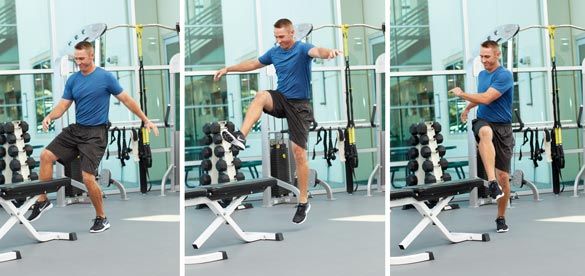
Single-legged Hurdler’s Drill —Stand behind one end of a weight bench or a Lebert Equalizer, balancing and hopping on the left leg. Raise the right leg in the air and “clear” the top of the bench, moving the right foot from the left side to the right side of the bench, going back and forth and still hopping on the left leg. Switch legs on the second round of the circuit.
Station 2
Traveling Push-ups—Begin at one end of an agility ladder. Laterally “walk” the hands and feet along the length of the ladder, performing a push-up every time you move your hands to a new position. Make sure to hit every square in the ladder.
Station 3
Medicine Ball Twists—Stand with the feet hip-width apart, holding a medicine ball in both hands. Extend the arms in front of you at chest height, while keeping the shoulders relaxed. Hold the arms extended as you perform torso rotations, alternating the position of the ball from side to side.
Station 4
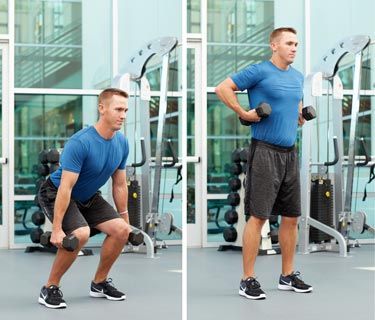
Squats + Monkey Rows—Stand with your arms at your sides while holding a dumbbell in each hand, palms facing in. Perform a squat, keeping the arms low. As you stand up from the squat, lift the arms as high as you can so the hands are beneath the underarms. Raise the elbows, bringing the dumbbells to the sides of the rib cage, with palms facing up.
Station 5
Push-up + Sandbag Pulls—Get into a push-up position with a sandbag on the floor, just behind the base of your left hand. Perform a push-up. At the top of the push-up, grab the sandbag with the right hand and drag it so it’s sitting just behind your right hand on the floor. Alternate sides.
Station 6
Step-up Knee Raises—Stand beside a sturdy weight-room bench with the right foot on the bench and the left foot on the floor. Keeping the right foot stationary, pull yourself up, raising the left knee in the air. Return to the starting position. Switch sides halfway through the allotted time. Switch legs on the second round of the circuit.
Core Circuit
Courtesy of Carol Murphy international fitness expert, Fairport, N.Y.
Number of Stations: 6
|
|
Circuit Set-up: 60 seconds per station, 10 to 30 seconds transition. Recover for one to two minutes between rounds; two rounds total. Equipment: body weight, one dumbbell, stability ball
|
|
Murphy’s Tip: When designing a core circuit to improve function and performance, think about how the spine moves in life (it bends, extends and twists). Consider exercises that mimic life actions (trunk extension, flexion, rotation and stabilization) and those that counteract the negative effects that gravity and daily life have on our posture.
|
Station 1
Reverse Wood Chop—While standing, hold a dumbbell in both hands, next to the left hip; bend the knees slightly. Keeping the arms straight, raise the dumbbell across the body until you’re standing straight and the dumbbell is above the right shoulder. Repeat the movement for 30 seconds on each side.
Station 2
Side Plank—From a push-up position, shift your body weight to the left hand. Rotate your body and raise your right arm until your arms and torso form a “T” shape. Slightly lower and lift the bottom hip three times before returning to a push-up position. Alternate sides.
Station 3
Plank Reach— Get into a plank position with the feet shoulder-width apart and forearms on the floor. Keep the torso still and brace the core as you diagonally extend the left arm into the air (imagine 10 o’clock position). Lower the left arm to the starting position and repeat with the right arm (imagine 2 o’clock position). Alternate sides.
Station 4

Bridge March—Begin in a supine position with the knees bent and the heels and arms on the floor. Push down through the heels and contract the glutes to lift the hips. At the top of the motion, your knees, hips and shoulders should all be in alignment. Lift the right knee toward the chest. Return to the starting position and then repeat on the left side; alternate sides.
Station 5
Stability Ball Side Crunch—Half-kneel to the right of a stability ball. Place the left side of your torso over the ball; press the left hip firmly into the ball, keeping the shoulders and hips aligned. Perform lateral trunk flexion by reaching the right hand toward the right ankle. Do 30 seconds on each side.
Station 6
Stability Ball Weighed Crunch—From a supine position on a stability ball, hold a dumbbell with both hands close to your chest. Curl the torso, stopping just short of upright. Slowly lower to the starting position.
References
Gotshalk, L.A., Berger, R.A. and Kraemer, W.J. (2004). Cardiovascular responses to a high-volume continuous circuit resistance-training protocol. Journal of Strength and Conditioning Research, 18, 4, 760-764.
Klika, B. and Jordan, C. (2013). High-intensity circuit training using body weight: Maximum results with minimal investment. ACSM’s Health & Fitness Journal, 17, 3, 8-13.
Kravitz, L. (2005). New insights into circuit training. IDEA Fitness Journal, 2, 4, 24-26.
Skidmore, B.L. et al. (2012). Acute effects of three different circuit weight training protocols on blood lactate, heart rate, and rating of perceived exertion in recreationally active women. Journal of Sports Science and Medicine, 11, 4, 660-668.





 by
by 








